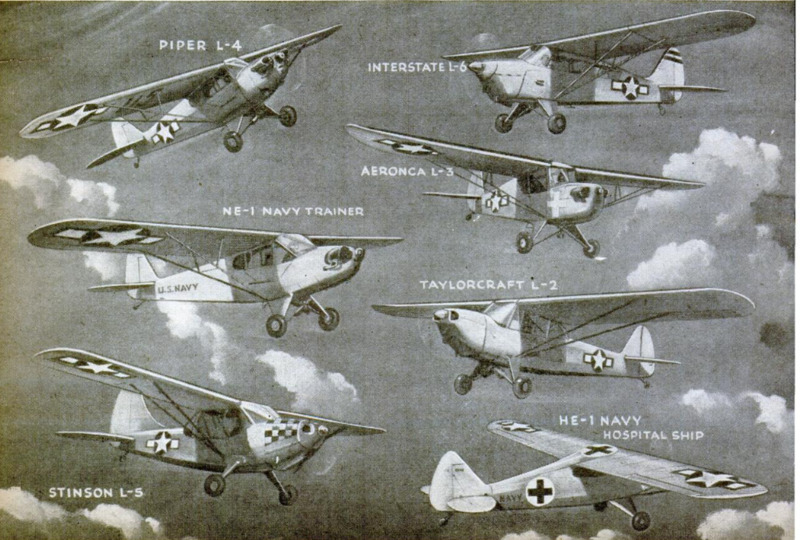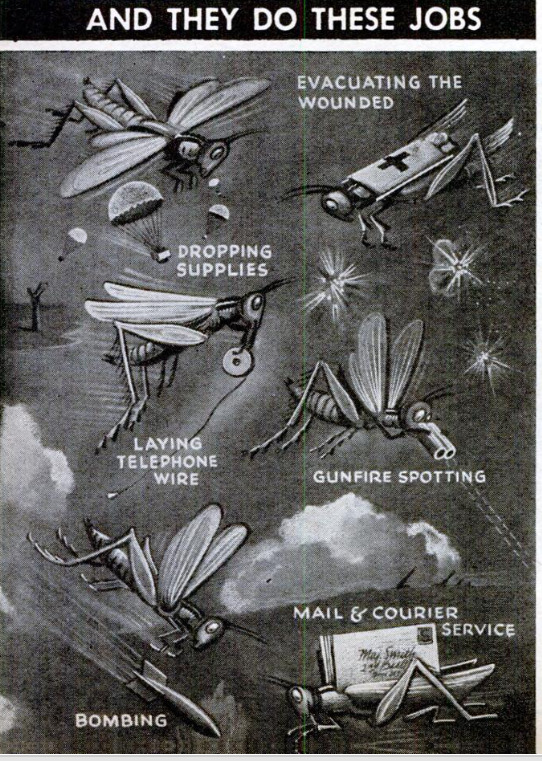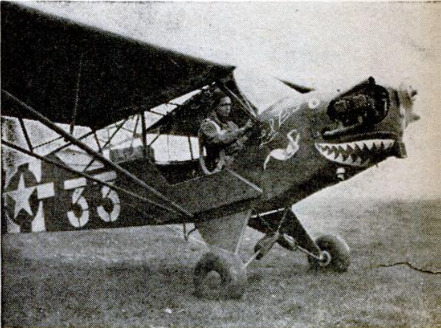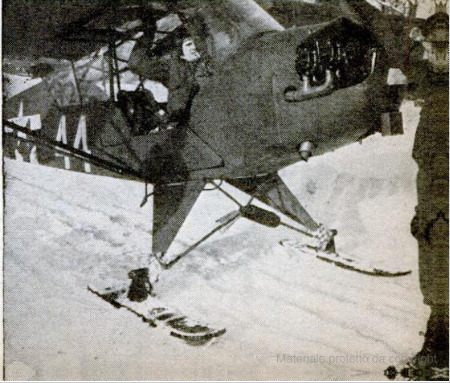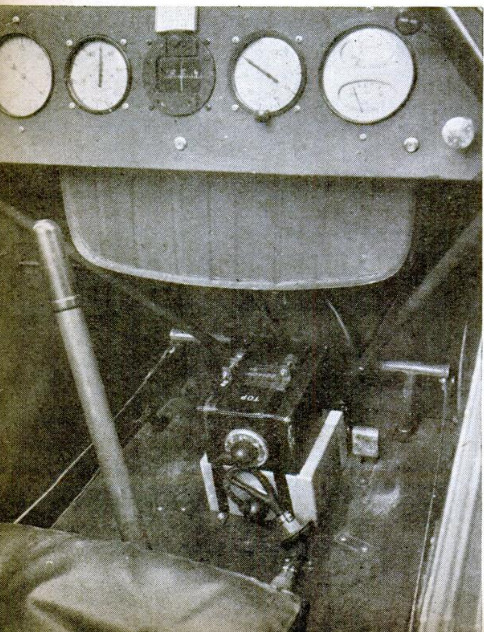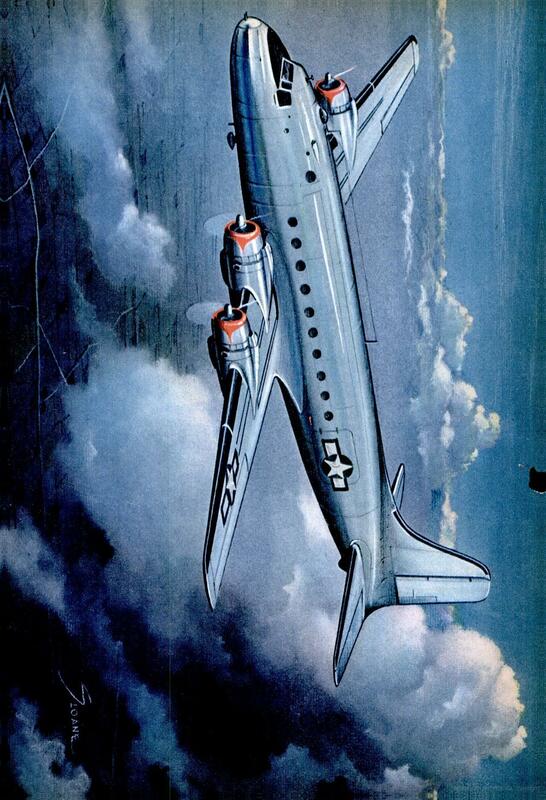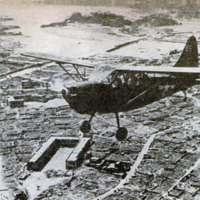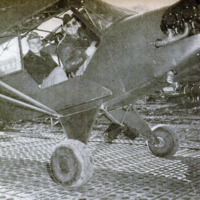-
Title (Dublin Core)
-
A dime is its landing field: jeep with wings
-
Article Title and/or Image Caption (Dublin Core)
-
A dime is its landing field: jeep with wings
-
extracted text (Extract Text)
-
ABOVE the treeless volcanic isles at
Japan's back door, a new kind of war
has been fought with a weapon more than
40 years old. The unarmed airplane, intro-
duced at the start of World War I, returned
to service to help drive the Japs into their
inner citadel.
In the fighting that marked the start of
the Kaiser's war, the flimsy aircraft of the
period were used solely for reconnaissance.
In the mobile, seaborne fighting of the
Mikadc's war, the role of the plane that
drops no bombs and shoots no bullets be-
came that of an airborne scout car, ambu-
lance, motorcycle, and artillery observa-
tion post.
Of all the weapons that have been given
wings for fighting in a third dimension, the
“grasshopper” plane, often fitted with an
engine of less power than that of a small
automobile, is the most versatile. Grass-
hoppers have been used for almost every-
thing that requires transportation, even in-
cluding the laying of telephone wire to ad-
vanced observation posts over mountains.
Because they are slow and fly at treetop
level, and therefore make poor targets for
either ground gunners or enemy fighter
pilots, they are ideal vehicles for carrying
messages, directing highway traffic, and
dropping supplies to units cut off by the
swift ebb and flow of battle.
The grasshoppers are the same thing as
the small private planes that used to dot
the grassy, postage-stamp airports through-
out the United States before the war. They
have changed only their garb. Some of
them have a little more horsepower. They
carry two-way radio. A limited number,
flying for the Army, the Navy, and the
Marine Corps, are equipped with stretchers
for ambulance work.
They require no regular landing fields.
The first of them on Guam—and they were
the first American planes to land there, as
well as on Iwo Jima—sat down on a short
strip of ground bucked flat by bulldozers.
They can put their wheels on the ground
and stop in less distance than the span of a
Superfortress wing. A favorite trick of the
grasshopper pilot facing an emergency is
to land in a treetop. It damages the plane,
but it's usually safe enough for the pilot.
With more affection than derision, the
grasshopper has been called a flying egg
beater, aeropeep, coffee grinder, and Maytag
Messerschmitt. It might well be called an
airjeep—aerial partner of the quarter-ton.
Airjeeps are at their best in artillery-
spotting work. Flying at 25 to 100 feet
above the ground, the pilot and his observer
—they carry a crew of only two—can see
everything on the ground.
During the invasion of Peleliu Island, in
the Palau group, airjeeps were flown off
carriers to direct Marine artillery fire. They
hovered over the Jap positions and radioed
ranges to the guns. During the shelling they
retired to an altitude of 1,000 feet to avoid
concussion. Then they swooped down to
report the results.
They topped off their performance at this
Jap outpost by directing the fire that de-
stroyed a flotilla of enemy barges loaded
with soldiers sent to reinforce the garrison
holed up in Bloody Nose Ridge.
The first Marine airjeep outfit organized
as a squadron went into action on Guam. Under the com-
mand of Maj. Gordon W. Heritage, of Wash-
ington, D. C., it was based on a CVE, an oil
tanker converted into a carrier. The ship
lay off Guam for three days while the
leathernecks went in over the beaches. Then |
the planes took off to establish a base at an
improvised landing strip on Orote Peninsula.
‘They had to land on a makeshift runway
because air and sea bombardment had pul-
verized Agana Field, the Jap airstrip. From
3,000 feet away the Japs were lobbing shells
from mortars and spraying the area with
machine-gun bullets. The airjeep crews
slept, when they could, behind bulldozers.
Daily they flew behind the Japs’ front |
lines. Within ten seconds after they took
off they were over enemy-held ground.
Winging just over the tops of the trees,
they helped shorten the Guam campaign
by days by directing the fire of 27 batteries
of Marine artillery, each with 12 guns.
One pilot caught the glint of sun on steel |
as he flew low over the jungle. He ordered
a concentration of fire. It cost the Japs
three big guns, 60 trucks, and 400 officers
and men.
In Italy, during the European war, air-
jeeps were used to lay telephone lines be-
tween command posts and forward obser-
vation positions in mountainous country that
was hard to get to. The airjeep pilots un-
reeled wire as they flew along.
In Burma airjeeps evacuated 400 wounded
British and Indian soldiers cut off by the
Japs on the Arakan front. From a hastily
built landing strip they had to fly nearly
1,000 miles in short hops back to their
home base.
In Algiers, an airjeep pilot sighted a herd
of gazelles roaming the countryside behind
the coastal hills. He organized a hunting
party and dropped several of the animals
with rifle fire from the air. A retriever in
a ground jeep collected the meat. Camp
cooks featured ‘gazelleburgers” on the
menu.
One airjeep was credited with downing a
Messerschmitt fighter. When the Nazi got
on his tail the airjeep pilot flew into a dead-
end ravine. Turning in a circle hardly wider
than the span of his own wing, the Ameri-
can pilot watched the German, unable to
maneuver out of the hole he had bungled
into, crash.
For two months airjeeps were used to
keep traffic rolling on the congested ‘Red
Ball Express” highway line between Cher-
bourg and Paris before American engineers
got the French railroads into operation.
Cruising back and forth above the narrow
ribbon of pavement, they radioed word of
traffic jams to the engineers charged with
keeping trucks moving.
The versatility of these lightplanes was
proved anew by Lt. Col. John C. L. Adams,
an infantry officer, during the invasion of
southern France. Twice he landed behind
the German lines in an airjeep to make
personal contact with the commanding of-
ficers of units that had been cut off.
Occasionally, airjeeps were fitted with
bazooka barrels on the under surface of
their wings, and the pilots attacked extra-
tough enemy gun positions with rockets. A
variation of the installation is a small bar-
rel platform on each wing strut. The ba-
zookas are fired with lanyards. One pilot
on the European front killed off targets as
big as German Tiger tanks (P.S.M., Feb.
45, p. 84).
The Germans, British, and Russians have
used their own types of airjeeps in a
variety of ways. It was a slow German
plane of exceptional performance, called
a Storch, that snatched Mussolini from Al-
lied captivity. Both the Germans and the
British used lightplanes to land saboteurs.
Red Army lightplanes were used to string
parachute flares that guided tanks to weak
spots in the German lines during the cam-
paign in the southern Ukraine. The Rus-
sians arm their airjeeps. They used them
for bombarding German artillery positions.
Fast thinking by a grasshopper pilot
probably saved the life of Gen. George S.
Patton in a close call on the European
Front. “Old Blood and Guts” was taking a
look at the battlefield from a small liaison
plane when a German fighter dived at it with
all guns blazing. Patton's pilot dropped the
grasshopper to treetop level, and the Nazi,
unable to pull out of his dive, crashed in
flames.
~ Alrjeep crews are proud of their outfits
and their planes, and they sometimes look
on the exploits of men who fly bigger,
heavier planes with an ironical humor. One
squadron in Italy organized a “bombing”
mission of eight planes. The ammunition
consisted of five-gallon tins of gasoline.
Over the target, a German airfield, they
solemnly unloaded their “bombs.”
Back on their home field they wrote a re-
port: “We failed to shoot down 120 enemy
planes. We did not obliterate the target,
and, despite flak which was not thick enough
to walk on, we did not start fires visible for
80 miles.”
-
Contributor (Dublin Core)
-
Devon Francis (article writer)
-
Language (Dublin Core)
-
eng
-
Date Issued (Dublin Core)
-
1945-07
-
pages (Bibliographic Ontology)
-
94-97,210,214
-
Rights (Dublin Core)
-
Public domain
-
Archived by (Dublin Core)
-
Sami Akbiyik
-
Marco Bortolami (editor)
 Popular Science Monthly, v. 147, n. 1, 1945
Popular Science Monthly, v. 147, n. 1, 1945

